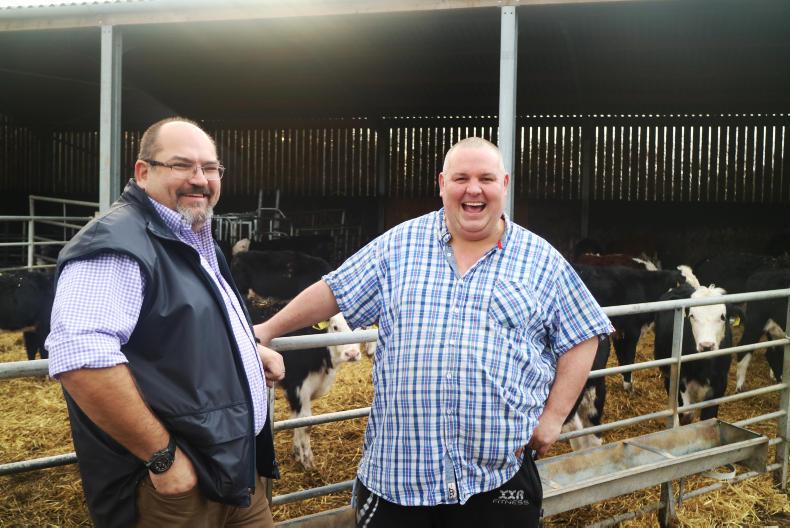In 2000, Rob Drysdale founded what would become Westpoint Veterinary Group at Horsham, outside London. In 2014, as managing director, he sold his majority stake in a business that is now the largest combined practice in the UK, covering almost 20% of British cattle (dairy and beef), 40% of pigs, 40% of poultry and providing specialist laboratory, research and consultancy services.
What next?
With his newfound freedom, Rob embarked on a Nuffield Scholarship, exploring beef production systems around the world. What struck him was the efficiency of scale and level of integration in other countries. There was incentivised co-operation right throughout these production lines that provided financial stability for all involved.
Could he bring some of it home?
“A couple of things became clear to me regarding the possibility of doing it at home,” he said. “Suckler beef integration would be a massive challenge. Like yours, our herds are far too small, not to mention diverse in genetics and targets. Integration begins at the endpoint: you need to be able to go to a customer offering consistency in quality and in numbers.
“Using dairy-bred beef was my best bet where large herds, use of AI and a consistent genetic base (Friesian cow) would allow scale and consistency.”
Processors
Rob met with processors (Dunbia Group), who showed interest in an integrated supply chain and were willing to agree a bonus above the conventional beef.
My system really needs £3.60/kg (€4.13), after add-ons, to work due to the retained ownership contract production I use
This bonus price was based on the conditions that (i) additional headage came during times of market scarcity, (ii) all animals were sired by 100% named Hereford sires and (iii) met a very tight weight and conformation specification.
“My system really needs £3.60/kg (€4.13), after add-ons, to work due to the retained ownership contract production I use. I get the Hereford bonus and a very modest premium from the processors themselves. When I reach bigger scale, there may be more bargaining power on my part.
Recruitment
Two of the biggest determinants of success in dairy beef are genetics and health. Rob could not have been better placed to get these right. Not alone was he a decorated vet, but he also knew the ins and outs of dozens of dairy, calf-rearing and beef farms in the area.
“The integrity of my model was going to be based on performance. I needed a top-class animal to be looked after and grown by top-class farmers.
There would be four elements to Rob’s system, with different personnel involved at each stage:
Calf sourcing.Calf-rearing.Growing.Finishing.“I got in contact with some of the really good guys I had worked with as a vet…”
Read part two and watch the video on farmersjournal.ie tomorrow
In 2000, Rob Drysdale founded what would become Westpoint Veterinary Group at Horsham, outside London. In 2014, as managing director, he sold his majority stake in a business that is now the largest combined practice in the UK, covering almost 20% of British cattle (dairy and beef), 40% of pigs, 40% of poultry and providing specialist laboratory, research and consultancy services.
What next?
With his newfound freedom, Rob embarked on a Nuffield Scholarship, exploring beef production systems around the world. What struck him was the efficiency of scale and level of integration in other countries. There was incentivised co-operation right throughout these production lines that provided financial stability for all involved.
Could he bring some of it home?
“A couple of things became clear to me regarding the possibility of doing it at home,” he said. “Suckler beef integration would be a massive challenge. Like yours, our herds are far too small, not to mention diverse in genetics and targets. Integration begins at the endpoint: you need to be able to go to a customer offering consistency in quality and in numbers.
“Using dairy-bred beef was my best bet where large herds, use of AI and a consistent genetic base (Friesian cow) would allow scale and consistency.”
Processors
Rob met with processors (Dunbia Group), who showed interest in an integrated supply chain and were willing to agree a bonus above the conventional beef.
My system really needs £3.60/kg (€4.13), after add-ons, to work due to the retained ownership contract production I use
This bonus price was based on the conditions that (i) additional headage came during times of market scarcity, (ii) all animals were sired by 100% named Hereford sires and (iii) met a very tight weight and conformation specification.
“My system really needs £3.60/kg (€4.13), after add-ons, to work due to the retained ownership contract production I use. I get the Hereford bonus and a very modest premium from the processors themselves. When I reach bigger scale, there may be more bargaining power on my part.
Recruitment
Two of the biggest determinants of success in dairy beef are genetics and health. Rob could not have been better placed to get these right. Not alone was he a decorated vet, but he also knew the ins and outs of dozens of dairy, calf-rearing and beef farms in the area.
“The integrity of my model was going to be based on performance. I needed a top-class animal to be looked after and grown by top-class farmers.
There would be four elements to Rob’s system, with different personnel involved at each stage:
Calf sourcing.Calf-rearing.Growing.Finishing.“I got in contact with some of the really good guys I had worked with as a vet…”
Read part two and watch the video on farmersjournal.ie tomorrow






 This is a subscriber-only article
This is a subscriber-only article












SHARING OPTIONS: